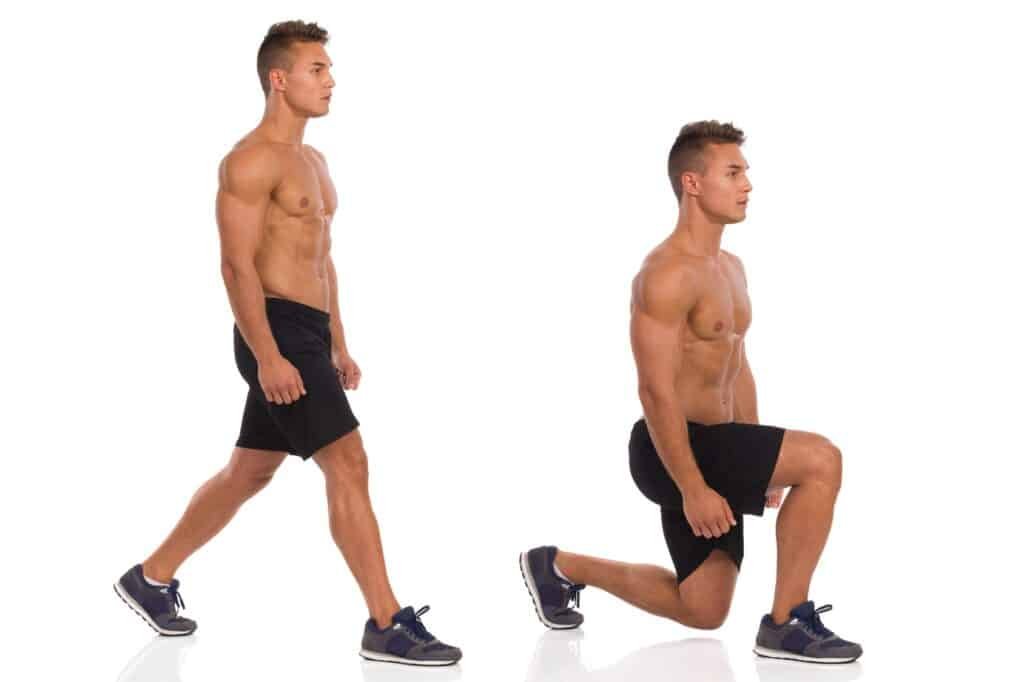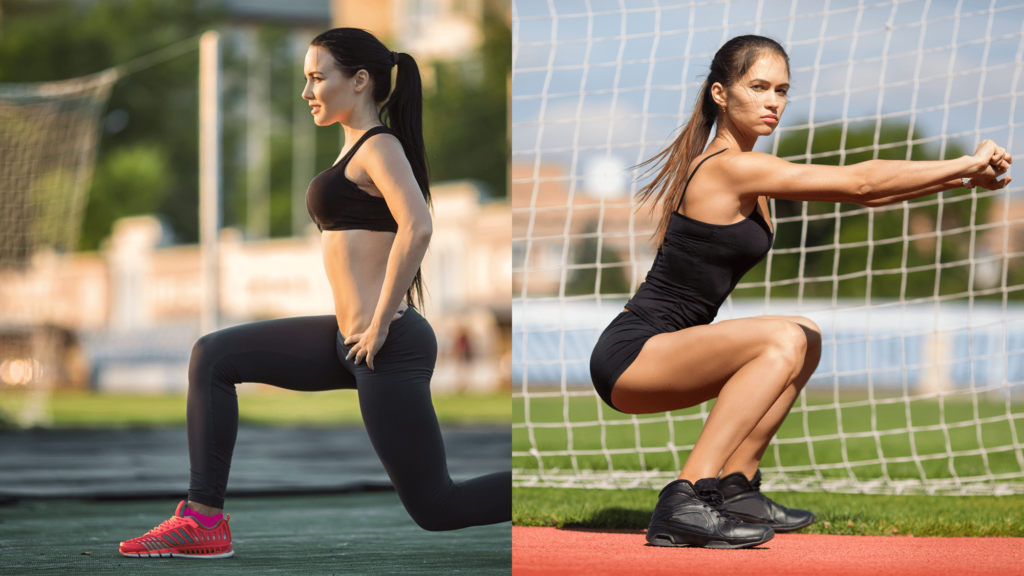Are split squats just as effective as back squats for building muscle? This question has sparked heated debates in gyms and online forums. Both exercises have their merits, but let’s cut through the noise. Split squats, often overlooked, pack a serious punch for muscle growth. They target multiple muscle groups and offer unique benefits. Back squats, the traditional king of leg day, have a long-standing reputation for building mass. But times are changing, and so is our understanding of hypertrophy. Recent research sheds new light on this comparison. It’s time to challenge old assumptions and explore the potential of split squats for muscle gains. Buckle up, because we’re about to dive deep into the science and practical applications of these powerhouse exercises.

The Fundamentals of Split Squats
Split squats are a unilateral lower-body exercise that target multiple muscle groups simultaneously, making them a time-efficient choice for hypertrophy. The primary muscles worked include the quadriceps, hamstrings, and glutes. But that’s not all – your core gets a workout too.
To perform a split squat, start with one foot forward and the other behind you. Lower your body until your back knee nearly touches the ground. Then, push through your front foot to return to the starting position. Sounds simple, right? Don’t be fooled. This exercise demands balance, stability, and strength.
One of the key benefits of split squats for hypertrophy is the increased time under tension. Each rep takes longer to complete compared to a traditional squat. This extended muscle engagement can lead to greater muscle damage and, consequently, more growth.
Split squats also allow for a greater range of motion in the hip joint. This increased stretch can stimulate more muscle fibers, potentially leading to better hypertrophy outcomes. Plus, the unilateral nature of the exercise helps address muscle imbalances. You’re not just building muscle; you’re building balanced, “functional” strength.
But here’s the kicker – split squats are surprisingly versatile. You can load them with dumbbells, a barbell, or even a weight vest. This flexibility allows for progressive overload, a crucial factor in driving muscle growth. So, are split squats good for hypertrophy? You bet your quads they are.

Comparing Split Squats to Back Squats
Split squats and back squats are both powerhouse exercises, but they’re not created equal. Let’s break it down. Back squats are the classic bilateral movement, hitting both legs simultaneously. Split squats, on the other hand, are unilateral, focusing on one leg at a time.
Muscle activation patterns differ significantly between these exercises. Back squats light up your quads, glutes, and lower back like a Christmas tree. Split squats, however, put more emphasis on your glutes and hamstrings, while giving your lower back a bit of a break.
Range of motion is another key difference. Back squats allow for a deeper squat, potentially leading to greater muscle stretch. Split squats, while more limited in depth, offer a unique challenge to your balance and stability.
Time under tension is where split squats shine. The unilateral nature of the exercise means each leg works independently, potentially doubling the time under tension compared to back squats. This increased time under tension can be a game-changer for hypertrophy.
Research shows that split squats may reduce lower back strain compared to back squats. This could be a crucial factor for those with back issues or looking to minimize spinal loading. However, don’t write off back squats just yet. They still reign supreme in terms of overall muscle mass activation.
In the end, both exercises have their place in a well-rounded hypertrophy program. It’s not about choosing one over the other, but rather understanding how to leverage the unique benefits of each for maximum gains.
Research Insights
Let’s dive into the science behind split squats and back squats. Recent studies have shed light on their effectiveness for muscle growth and lower back health. A study by Mackey and Reimann, 2021 compared the Bulgarian split squat (BSS) to the traditional back squat. The findings? BSS may be easier on your knees and lower back. It’s a hip-dominant exercise, making it a smart choice if you’re looking to minimize back strain.

But what about muscle activation? A study conducted by Schellenberg et al., 2017 analyzed muscle forces during various lower-body exercises. Split squats hit the glutes hard while being gentler on the lower back compared to deadlifts and back squats. This is great news if you’re after that coveted booty gains without the back pain.
Now, let’s talk about the lower back specifically. A 2014 study found that back squats light up the lower erector spinae muscles more than rear-leg elevated split squats or traditional split squats. Translation? Split squats might be your new best friend if you’re prone to lower back issues.
But don’t count out back squats just yet. They still reign supreme for overall muscle activation. A study on trunk muscle activity during squats and deadlifts showed significant erector spinae activation at 80% of 1RM. However, this higher activation could be a double-edged sword if you’re battling back pain.
Split squats hit the glutes hard while being gentler on the lower back compared to deadlifts and back squats
The takeaway? Both exercises have their merits. Split squats offer a back-friendly alternative without sacrificing muscle growth potential. Back squats, while more demanding on the spine, provide unparalleled overall muscle activation. Choose wisely based on your goals and physical condition.

Practical Applications
Split squats are a versatile tool for hypertrophy. They’re not just for show-offs or balance freaks. Incorporate them into your program and watch your gains skyrocket. Start with bodyweight split squats to nail the form. Once you’ve got it down, add dumbbells or a barbell. Progress by increasing weight, reps, or sets. Don’t be afraid to go heavy – your legs can handle it.
Want to spice things up? Try Bulgarian split squats. They’ll make your quads scream and your glutes grow. For an extra challenge, use a elevated platform for your back foot. This increases the range of motion and intensifies the stretch on your hip flexors.
Split squats are also great for fixing muscle imbalances. We all have a dominant side, but unilateral exercises like these even things out. They force each leg to work independently, preventing your stronger side from compensating. This leads to more symmetrical muscle growth and reduced injury risk.
Remember, variety is key for hypertrophy. Don’t ditch back squats entirely. Instead, use split squats as a complement. Alternate between the two exercises in your program. Your legs will thank you, and your gains will show it.

Expert Opinions
Let’s cut through the noise and get to the meat of the matter. Strength coaches and bodybuilders have been debating split squats vs. back squats for years. Here’s what the pros are saying.
Mike Boyle, a renowned strength coach, swears by split squats. He’s ditched back squats entirely in favor of unilateral work. Bold move, Mike. His reasoning? Better transfer to sport and reduced lower back stress. Can’t argue with results.
On the flip side, powerlifting legend Louie Simmons wasn’t a fan. He believed bilateral movements were superior for overall strength development. Fair point, Louie. But we’re talking hypertrophy here, not just raw strength.
IFBB Pro Ben Pakulski takes a middle ground. He advocates for both exercises in a well-rounded program. Smart man. Ben emphasizes the mind-muscle connection during split squats, claiming it’s easier to target specific muscles.
Dr. Brad Schoenfeld, the hypertrophy guru himself, has conducted studies showing similar muscle growth from unilateral and bilateral exercises. His take? Both have their place. It’s about total volume and progressive overload.
Charles Poliquin, may he rest in peace, was a big proponent of split squats for addressing muscle imbalances. He argued that most lifters have strength discrepancies between legs, which split squats can help correct.
The consensus? Split squats are legit for hypertrophy. They’re not just some balance exercise for soccer moms. But don’t throw out your back squat just yet. The smart money’s on using both exercises for maximum gains.

Common Misconceptions
Let’s bust some myths about split squats. First up, the “split squats are just for balance” nonsense. Sure, they’ll improve your balance, but that’s not their main gig. Split squats are muscle-building powerhouses. They target your quads, glutes, and hamstrings with laser-like precision. Plus, they’re unilateral, meaning they’ll expose and fix any strength imbalances you’ve been hiding.
Now, about that knee stress worry. It’s time to put that one to bed. Research shows split squats actually reduce knee joint stress compared to back squats. The Bulgarian split squat, in particular, is a hip-dominant movement. This means less pressure on your knees and more focus on those glutes and hamstrings. So, if you’re nursing cranky knees, split squats might be your new best friend.
Don’t fall for the “only compound lifts build muscle” trap either. Split squats are compound movements. They engage multiple muscle groups and joints simultaneously. This makes them excellent for hypertrophy, not just some balance act you do between “real” exercises.
Lastly, some folks think split squats can’t be loaded heavy enough for real gains. Wrong again. With proper form and progression, you can load up split squats to challenge even the burliest lifters. Remember, it’s not just about the weight on the bar. It’s about the stress on the muscle. And split squats deliver that in spades.
Recent Developments
Recent research has shed new light on unilateral training for hypertrophy. A 2018 study found that single-leg exercises like split squats can produce comparable muscle growth to bilateral movements. This challenges the notion that heavy bilateral lifts are superior for hypertrophy.
Emerging trends in exercise prescription favor a more balanced approach. Trainers are increasingly incorporating unilateral exercises into hypertrophy programs. This shift recognizes the unique benefits of exercises like split squats for muscle development and functional strength.
New data suggests that unilateral training may enhance muscle activation in certain muscle groups. A 2014 study observed higher glute and hamstring activation during split squats compared to traditional back squats. This finding has implications for targeted muscle growth strategies.
The fitness industry is taking note of these developments. More gyms are now equipped with specialized equipment for unilateral training. This trend reflects the growing recognition of split squats and similar exercises as valuable tools for muscle building.
Conclusion
Split squats and back squats both have their place in a well-rounded hypertrophy program. The research shows that split squats offer unique benefits, including reduced lower back stress and targeted unilateral muscle activation. They’re not just a balance exercise – they’re a serious muscle-builder. Back squats remain a staple for overall lower body development, but split squats can be equally effective for hypertrophy when programmed correctly. The key is to understand your goals and body mechanics. If you’re looking to maximize muscle growth while minimizing lower back strain, split squats are a smart choice. Remember, variety in your training stimuli is crucial for continued progress. So, don’t be afraid to split from tradition and embrace the split squat. Your gains (and your lower back) might thank you for it.
References
- Mackey, E. R., & Riemann, B. L. (2021). Biomechanical differences between the Bulgarian split-squat and back squat. International Journal of Exercise Science, 14(1), 533-543.
- Schellenberg, F., Taylor, W. R., & Lorenzetti, S. (2017). Towards evidence based strength training: a comparison of muscle forces during deadlifts, goodmornings and split squats. BMC Sports Science, Medicine and Rehabilitation, 9(1), 13.
- DeForest, B. A., Cantrell, G. S., & Schilling, B. K. (2014). Muscle activity in single- vs. double-leg squats. International Journal of Exercise Science, 7(4), 302-310.
- Hamlyn, N., Behm, D. G., & Young, W. B. (2007). Trunk muscle activation during dynamic weight-training exercises and isometric instability activities. Journal of Strength and Conditioning Research, 21(4), 1108-1112.
- Fletcher, I. M., & Bagley, A. (2014). Changing the stability conditions in a back squat: the effect on maximum load lifted and erector spinae muscle activity. Sports Biomechanics, 13(4), 380-390.
- Maddigan, M. E., Button, D. C., & Behm, D. G. (2014). Lower-limb and trunk muscle activation with back squats and weighted vest squats. Journal of Strength and Conditioning Research, 28(12), 3346-3353.
- Deniz, S., & Ulas, Y. H. (2019). Evaluation of muscle activities during different squat variations using electromyography signals. In 2019 Medical Technologies Congress (TIPTEKNO) (pp. 1-4). IEEE.




La weekly This is really interesting, You’re a very skilled blogger. I’ve joined your feed and look forward to seeking more of your magnificent post. Also, I’ve shared your site in my social networks!
I appreciate the kind words. Thank you so much!!!